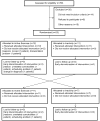Highly Challenging Balance Program Reduces Fall Rate in Parkinson Disease
- PMID: 26655100
- PMCID: PMC4681297
- DOI: 10.1097/NPT.0000000000000111
Highly Challenging Balance Program Reduces Fall Rate in Parkinson Disease
Abstract
Background and purpose: There is a paucity of effective treatment options to reduce falls in Parkinson disease (PD). Although a variety of rehabilitative approaches have been shown to improve balance, evidence of a reduction in falls has been mixed. Prior balance trials suggest that programs with highly challenging exercises had superior outcomes. We investigated the effects of a theory-driven, progressive, highly challenging group exercise program on fall rate, balance, and fear of falling.
Methods: Twenty-three subjects with PD participated in this randomized cross-over trial. Subjects were randomly allocated to 3 months of active balance exercises or usual care followed by the reverse. During the active condition, subjects participated in a progressive, highly challenging group exercise program twice weekly for 90 minutes. Outcomes included a change in fall rate over the 3-month active period and differences in balance (Mini-Balance Evaluation Systems Test [Mini-BESTest]), and fear of falling (Falls Efficacy Scale-International [FES-I]) between active and usual care conditions.
Results: The effect of time on falls was significant (regression coefficient = -0.015 per day, P < 0.001). The estimated rate ratio comparing incidence rates at time points 1 month apart was 0.632 (95% confidence interval, 0.524-0.763). Thus, there was an estimated 37% decline in fall rate per month (95% confidence interval, 24%-48%). Improvements were also observed on the Mini-BESTest (P = 0.037) and FES-I (P = 0.059).
Discussion and conclusions: The results of this study show that a theory-based, highly challenging, and progressive exercise program was effective in reducing falls, improving balance, and reducing fear of falling in PD.Video abstract available for more insights from the authors (see Supplemental Digital Content 1, http://links.lww.com/JNPT/A120).
Trial registration: ClinicalTrials.gov NCT02302144.
Conflict of interest statement
There were no conflicts of interest for any of the authors.
Figures
References
-
- Campbell AJ, Robertson MC, Gardner MM. Elderly people who fall: identifying and managing the causes. Br J Hosp Med. 1995;54(10):520–3. - PubMed
-
- Schrag A, Jahanshahi M, Quinn N. How does Parkinson’s disease affect quality of life? A comparison with quality of life in the general population. Mov Disord. 2000;15(6):1112–8. - PubMed
-
- Genever RW, Downes TW, Medcalf P. Fracture rates in Parkinson’s disease compared with age- and gender-matched controls: a retrospective cohort study. Age Ageing. 2005;34(1):21–24. - PubMed
-
- Spottke AE, Reuter M, Machat O, et al. Cost of illness and its predictors for Parkinson’s disease in Germany. Pharmacoeconomics. 2005;23(8):817–836. - PubMed
Publication types
MeSH terms
Associated data
Grants and funding
LinkOut - more resources
Full Text Sources
Other Literature Sources
Medical
Miscellaneous




